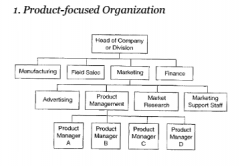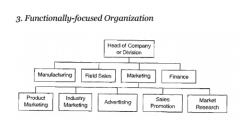![]()
![]()
![]()
Use LEFT and RIGHT arrow keys to navigate between flashcards;
Use UP and DOWN arrow keys to flip the card;
H to show hint;
A reads text to speech;
10 Cards in this Set
- Front
- Back
|
How does an organizational structure affect how a marketing task gets done? (cespedes) |
1. The type and flow of information and the resource allocation. 2. The processes within a firm and a functional areaa. Structure affects who interacts with who and with what goals and interests in b. It helps determine the focus of attention for managers. 3. The kinds of skills that are developed over time --> affect the marketing strategies.mind. |
|
|
On what does the choice of organizational structure depend? (cespedes) |
The choice of organizational structure depends on the relative routinization vs. customizationof key tasks to be performed by the organization. |
|
|
Meaning? |
If key tasks are: Relatively routinely: Coordination can be achieved by centralized plan that aremanaged through hierarchy --> functionally focused organization appropriate. Of problem-solving sort, requiring collaboration: The need of integrated marketing plans are important often customized to needs of either different products or markets --> Product or market focused organization appropriate. |
|
|
What is important with the product-focused organization? |

|
|
|
What is essential with the market focused organization? |

|
|
|
What is important with the functionally focused organisation? |

|
|
|
How can the Cespedes article be used? |
1. When wanting to know which organizational structure a company should have. E.g. analysiing a current one and see if it is appropriate, and seeing which one is relevant. 2. The framework with all 3 structures is presented and can be used. (6 areas are covered: type of manager, main task/main responsibility of manager, typical for what marktet/goods situation, weaknesses, strenthgs, key success factors) |
|
|
What is the main theme of Kalyaman & Bar? |
This article concerns the management of thereseller channel, i.e. partners who are selling your company’s products,also called Value-Add Resellers (VARs). It talks about two approaches for managing andcompensating VARs; the Volume-based compensation model (which is acommon approach), and the Value-based compensation model (which is theone that the authors argue for). The article brings forth key problems with theVolume-based model and elaborates on the use and key features of the Value-basedmodel, exemplified through the case of Cisco Systems. Chosing which compensation model to used is an important strategic choice for managers. |
|
|
Background. |
As customer needs become moresophisticated, markets typically evolve from selling standardized products tocustomized solutions. The design and installation of these more complex solutionsare typically led by channel partners – Value-Add Resellers (VARs),who are closer to understanding customer needs. VARs integrate hardware,software, and third-party products to deliver solutions that are customized tomeet specific end-user requirements. VARs also provide pre- and post-salesservices such as planning, design, installation, support, remote monitoring,and management. |
|
|
How can Kalyanam and Bar's article be used? |
1. When discussing the management of reseller channels. |

